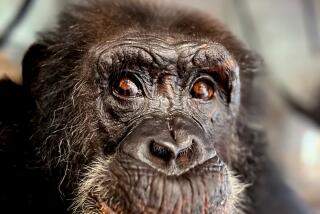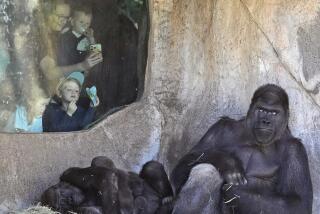Even Zoo Animals Go Ape at Annual Bout With the Flu
If the story could be told by the look in a pair of dark brown eyes, surely the nasty tale of a bout with the winter flu would unfold in a few doleful glances from an ailing chimpanzee.
A cough, a raspy throat, a weak âAchoo!â are also signs of a great ape suffering the flu, a respiratory disease that tends to strike apes in the same seasonal cycles as humans.
âAnimals never moan. You lose the moan factor,â said Dr. Warren Thomas, a veterinarian and director of the Los Angeles Zoo, suggesting how such mournful vocalizations might signal any number of maladies that can afflict a fellow primate.
âBut they respond the same way to the (flu) virus as a human, have the same symptoms, run a temperature the same way and react the same way to drugs,â he said.
Thomas has found that watching for signs and symptoms of illness is of special importance during winter months when animal behavior can turn listless, a sure sign that the influenza virus is conducting its sinister business in the cells of an otherwise healthy chimp.
Because influenza viruses are airborne pathogens of a variety of strains that are most prevalent during winter, the workload increases at zoos during a season when people--zookeepers included--are also battling the flu, Thomas said.
Part of the art and science of diagnosing a monkey with the flu, according to the veterinarian, is being able to translate the animalâs body language. A monkey may clasp its hands to its throat to express soreness or take refuge in a quiet corner, head hung low and eyes cast down, when the headache brought on by the flu is too much to bear.
âThey canât tell us where it hurts,â Thomas said of his patients. âA physician has the advantage of talking to his patients. The vet has to look at all of these subtle signs and draw conclusions about what the animal is feeling.
âWhen you hear this rap about old folks and children needing to be vaccinated against the flu, we take heed and immunize high-risk animals. We use the same vaccines that people get.â
Line Up for Flu Shots
In effect, Thomas said, the keepers and staff veterinarians line up certain chimpanzees, gorillas, orangutans and other primates for their flu shots in an annual ritual aimed at warding off infection.
The vaccines used in the animals consist primarily of âkilledâ flu viruses that activate an immune response against the respiratory viral infection when injected into a healthy animal that is not suffering from the flu.
Thomas said he uses the same âFDA-approved vaccinesâ that physicians employ in the inoculation of people.
âWe take other precautions too,â said Thomas.
âWe have a policy that our keepers who work around primates stay home when they feel as if theyâre coming down with something. We donât want them playing martyr, working while theyâre sick and playing âTyphoid Maryâ to our primates.â
âYouâre dealing with a cadre of people who love their animals,â Thomas said of the keepers and vets on the zooâs staff. âBut in spite of all of the efforts we go through to keep the animals healthy, we end up with a gorilla, monkey or orangutan with the flu.â
Taken to Health Center
To prevent the spread of the virus to other animals and to better care for a flu-stricken monkey, keepers sometimes take an infected animal to the zooâs health center where, if necessary, antiviral medications can be administered by intravenous drip, Thomas said.
âWhen I got out of vet school, I thought there was nothing I couldnât deal with. But experience has taught me that that wasnât true,â said Thomas.
More to Read
Sign up for Essential California
The most important California stories and recommendations in your inbox every morning.
You may occasionally receive promotional content from the Los Angeles Times.










